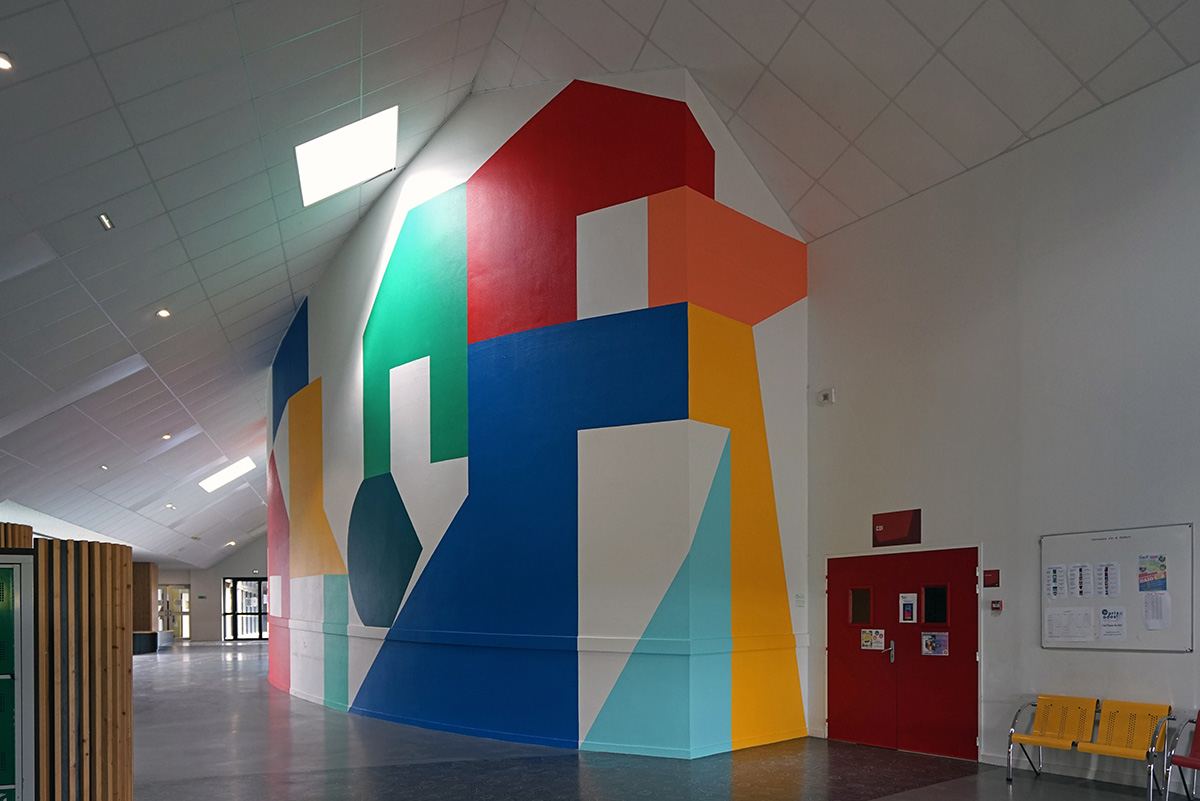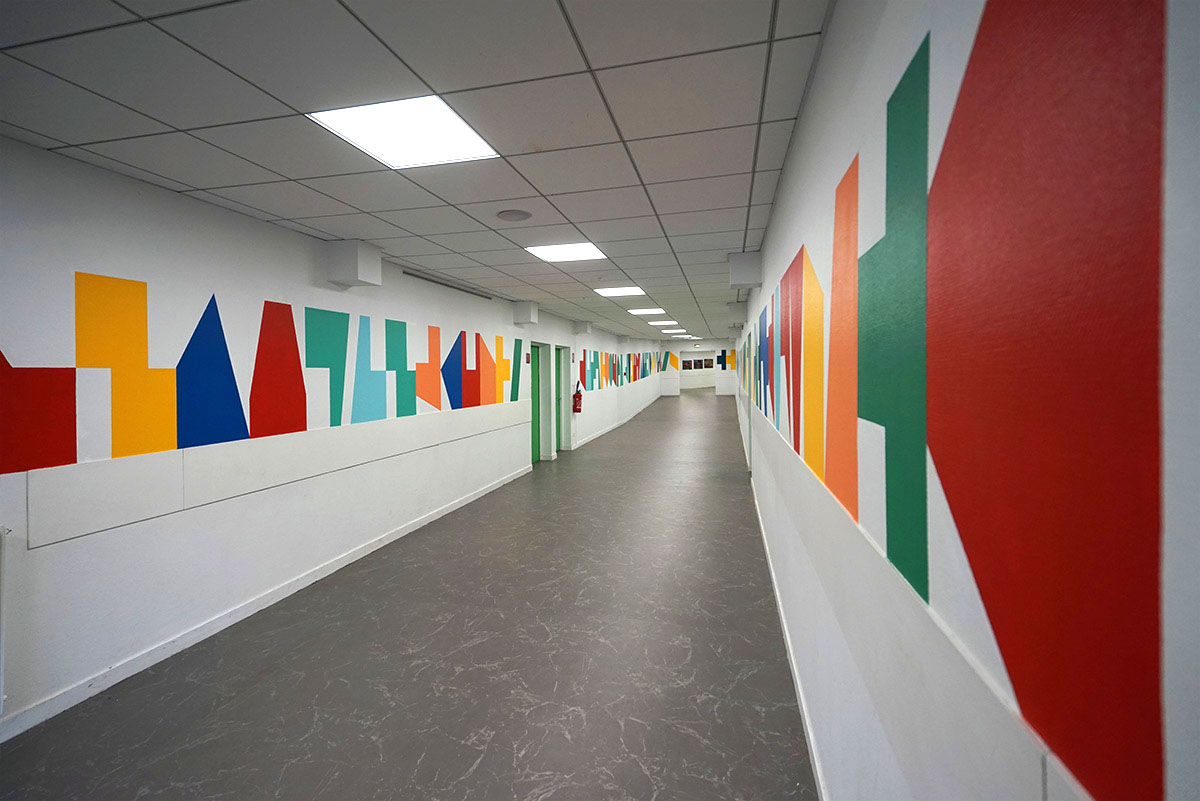Composition sur bâtiment CSB#30(i)
Bâtiment Phebe, Rouen, France
Janvier 2025
Projet commissionné par Nicolas Couturieux.
Peinture murale générative et participative Modo n.º56
Et composition sur bâtiment (intérieur) CSB n.º29
Collège Évariste Gallois, Montauban de Bretagne, France
Février et mai 2024
Projet commissionné et organisé par Teenage Kicks avec le département d’Ille-et-Vilaine.


Première phase avec 170 participants, février 2024 :
Processus :
Mur fini :
Un grand merci à Mathias, Amélie, Érine, Claire et tous les élèves de 4e.
Varsi Art Lab, Rome, Italie
Juin 2023
Pendant les deux semaines de la résidence, avec le soutien de 56Fili, j’ai eu l’opportunité d’expérimenter autour de la sérigraphie, perturbant ses usages conventionnels et l’utilisant comme une extension de ma recherche artistique et esthétique.
La méthodologie appliquée à mes projets d’art génératif (Modo, Eltonolab, etc.) a été mise en œuvre dans les productions de la résidence. Dans un subtil équilibre entre règles et hasard, une nouvelle collection d’œuvres sérigraphiques a émergé, rompant avec les normes habituelles des séries au profit de l’unicité.
J’ai créé trois nouvelles collections :
Photos : Ornella Mercier (@ornella.mercier)
Palais des Beaux-Arts de Lille, France
Octobre 2023
Dans le cadre de ses actions d’inclusion et de diversification de ses publics, le Palais des Beaux-Arts de Lille a ouvert à l’automne 2023 un espace gratuit dédié aux enfants de 0 à 6 ans au cœur de son atrium, en partenariat avec le centre d’initiation à l’art Mille Formes de Clermont-Ferrand. L’idée étant de faire vivre aux tout-petits une première expérience artistique multisensorielle autour des formes et des couleurs grâce à des œuvres contemporaines.
Aux côtés de Claude Como, j’ai été invité à présenter mon dispositif Espaces Manipulables conçu en 2022 avec le centre d’initiation à l’art Mille Formes. Additionnellement, j’ai été invité à peindre le mur extérieur de l’espace d’exposition dans l’atrium du musée. J’y ai exécuté la peinture générative Modo n.°55 en sept jours.
Modo n.°55, peinture murale générative :
1, 2, 3 couleurs est un projet imaginé et porté par le service Médiation et implication des publics du Palais des Beaux-Arts de Lille / Ville de Lille. Il a bénéficié du mécénat Rigolo Comme La Vie en collaboration avec le fonds de dotation We Act for kids Fond’actions et du mécénat en nature d’Unikalo.
Photos : Eltono
Palais des Beaux-Arts de Lille, France
Octobre 2023
Dans le cadre de ses actions d’inclusion et de diversification de ses publics, le Palais des Beaux-Arts de Lille a ouvert à l’automne 2023 un espace gratuit dédié aux enfants de 0 à 6 ans au cœur de son atrium, en partenariat avec le centre d’initiation à l’art Mille Formes de Clermont-Ferrand. L’idée étant de faire vivre aux tout-petits une première expérience artistique multisensorielle autour des formes et des couleurs grâce à des œuvres contemporaines.
Aux côtés de Claude Como, j’ai été invité à présenter mon dispositif Espaces Manipulables conçu en 2022 avec le centre d’initiation à l’art Mille Formes. Additionnellement, j’ai été invité à peindre le mur extérieur de l’espace d’exposition dans l’atrium du musée. J’y ai exécuté la peinture générative Modo n.°55 en sept jours.
Modo n.°55, peinture murale générative :
Espaces Manipulables, installation :
1, 2, 3 couleurs est un projet imaginé et porté par le service Médiation et implication des publics du Palais des Beaux-Arts de Lille / Ville de Lille. Il a bénéficié du mécénat Rigolo Comme La Vie en collaboration avec le fonds de dotation We Act for kids Fond’actions et du mécénat en nature d’Unikalo.
Photos : Eltono
Redline Centre d’Art Contemporain
2350 Arapahoe Street, Denver, U.S.A.
30 juin – 23 juillet 2017
Modo n.º19
(Texte en anglais)
Curated by Ramón Bonilla, Downshifting is a group exhibition that calls attention to the meditative quality of reductive art, which encompasses minimal, post-minimal, hard edge and geometrical work. Reductive art work is typically explored in terms of formal qualities like medium, rarely conjuring conversations that respond or reflect on political realities. For many artists around the globe, however, reductive work can provide a sanctuary from the hyperactivity and sensory-flooding that has come to be our everyday reality.
Working with 12 internationally-based abstract and minimalist artists, Downshifting will transform RedLine’s 6,000-square-foot exhibition hall into a sanctuary of abstract works with programming that explores sensory deprivation rather than spectacle and provocation.
Participating Artists:
Eltono (France)
Louyse Blyton (Australia)
Ramón Bonilla (Puerto Rico)
Sandra Fettingis (USA)
Andrew Huffman (USA)
Kristofer Hultenberg (Denmark)
Michael Mork (Denmark)
Gary Andrew Clarke (England)
Ashley Frazier (USA)
SEIKON (Poland)
Hyland Mather (USA)
Frank T. Martinez (USA)
Downshifting exposition collective
Redline Centre d’Art Contemporain
2350 Arapahoe Street, Denver, U.S.A.
30 juin – 23 juillet 2017
(Texte en anglais)
Curated by Ramón Bonilla, Downshifting is a group exhibition that calls attention to the meditative quality of reductive art, which encompasses minimal, post-minimal, hard edge and geometrical work. Reductive art work is typically explored in terms of formal qualities like medium, rarely conjuring conversations that respond or reflect on political realities. For many artists around the globe, however, reductive work can provide a sanctuary from the hyperactivity and sensory-flooding that has come to be our everyday reality.
Working with 12 internationally-based abstract and minimalist artists, Downshifting will transform RedLine’s 6,000-square-foot exhibition hall into a sanctuary of abstract works with programming that explores sensory deprivation rather than spectacle and provocation.
Participating Artists:
Eltono (France)
Louyse Blyton (Australia)
Ramón Bonilla (Puerto Rico)
Sandra Fettingis (USA)
Andrew Huffman (USA)
Kristofer Hultenberg (Denmark)
Michael Mork (Denmark)
Gary Andrew Clarke (England)
Ashley Frazier (USA)
SEIKON (Poland)
Hyland Mather (USA)
Frank T. Martinez (USA)